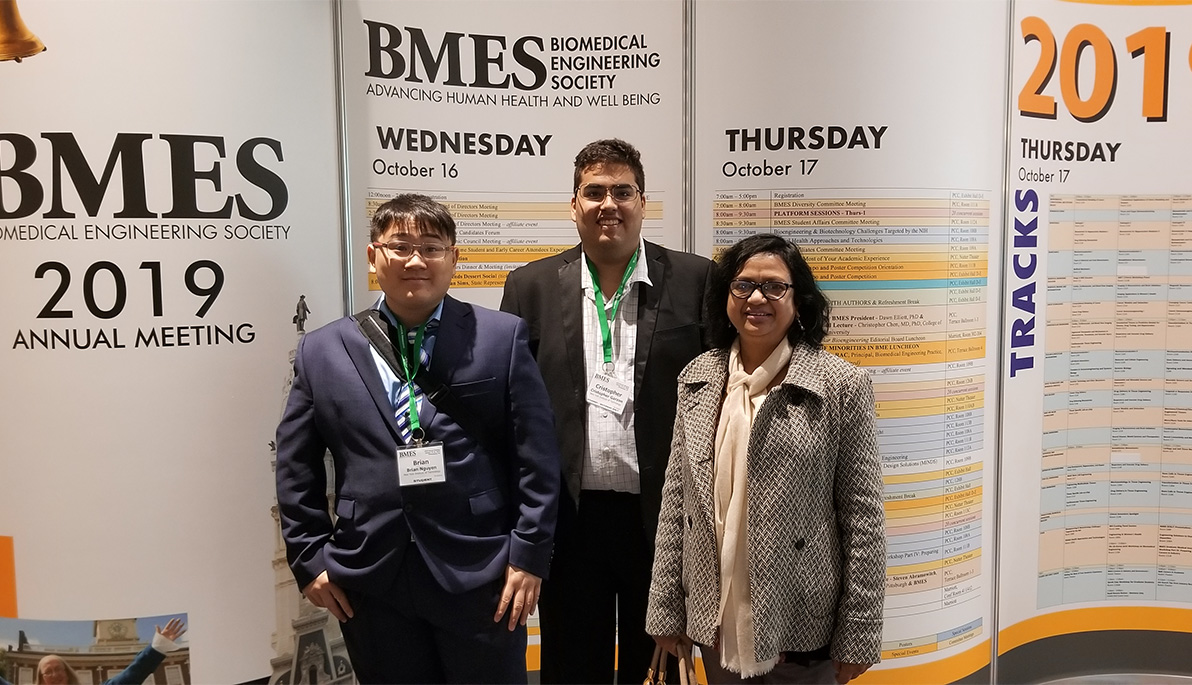
Undergrads Use Computing to Detect Cancer
November 5, 2019
Pictured from left, Brian Nguyen, Cristopher Garzon, and Niharika Nath at the 2019 Biomedical Engineering Society Meeting in Philadelphia.
The Pap smear test, which women undergo routinely as part of an annual physical exam, is the standard detection procedure to identify abnormal cervical cells that can lead to cancer. As part of this test, a cytopathologist examines sample cells under a microscope. However, the process is vulnerable to human error.
Cristopher Garzon and Brian Nguyen, undergraduate students in the Department of Biological and Chemical Sciences, worked on a study to standardize and computerize the detection of abnormal cells of the cervix. They presented their research poster, “Image Analysis of Human Cervical Cells for Nucleus Features: Classification into Precancerous and Normal Cells,” at the annual meeting of the Biomedical Engineering Society (BMES).
The students worked with faculty mentor Niharika Nath, Ph.D., a cancer research expert, and Raghul Elangovan, a master’s candidate in computer science. The team developed a computerized, quantified analysis of the key features of cervical cells that would correlate with dangerous abnormalities.
Using images of known abnormal cell nuclei as well as images of normal nuclei, Garzon and Nguyen identified 13 characteristics they thought might be closely tied to cancer. Elangovan then coded a program in Matlab to describe each nucleus based on these parameters. They analyzed the resulting data using dozens of Excel spreadsheets.
Nguyen, a senior majoring in life sciences – biomedical engineering, explains, “Our hypothesis was that various features of the nucleus’s shape in a precancerous cell would be significantly different from those of a normal nucleus.” Their data analysis showed that of the 13 features they described, six of them met that standard: they differed significantly from normal cells.
Nath proposed the project to the students as their summer research internship, and she guided them throughout the study. She also encouraged them to present their findings at BMES 2019, held this year in Philadelphia. “We all felt very excited when our poster was accepted,” says Garzon, a junior biotechnology major. “It felt like a real achievement, considering the hours we spent pre-processing the data.” NYIT College of Arts and Sciences and the Department of Biological and Chemical Sciences sponsored the students.
When it came time to share their research with crowds of experts, “We felt prepared,” says Garzon, “and our work was received positively. We had multiple Ph.D. students and university faculty ask us challenging questions about our poster.” Nguyen adds, “A couple of people suggested methodology for future research that we had already considered, so being on the same page about that with more experienced people was great for our confidence.”
More Features

An Alumnus’ Commitment to the Environment
As an energy management graduate from New York Tech’s Vancouver campus, Jasdeep Gulati (M.S. ’22) is highly invested in educating people about environmental and climate sustainability.

Vancouver Faculty Win University-Sponsored Research Awards in New Program
The new Global Impact Research Grant (GIRG) program has been developed to keep Vancouver-based faculty connected to faculty and research projects being conducted on the university’s New York campuses.

Studying Climate Change One Degree at a Time
Junhua Qu (M.S. ’24) began her collegiate journey in Beijing. But, her interest in climate change took her to New York Tech’s Vancouver campus to study energy management.
